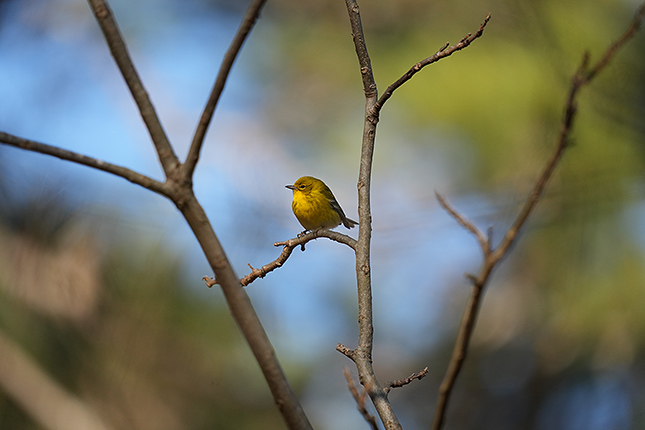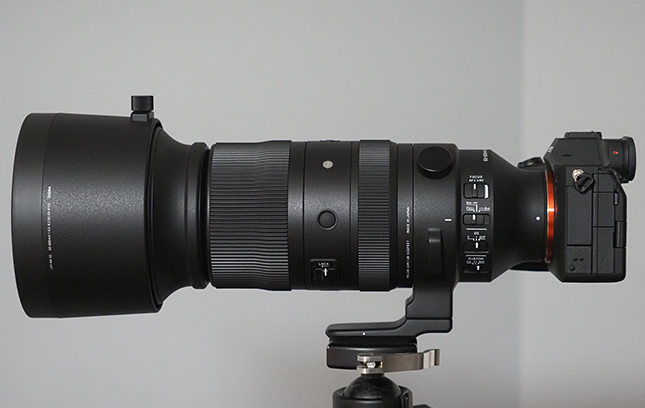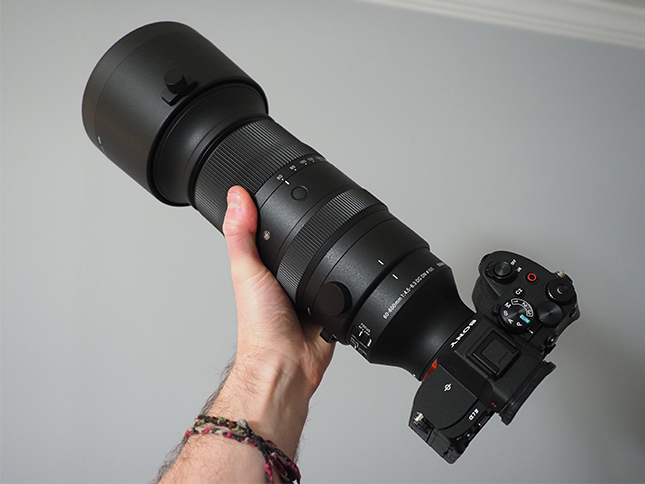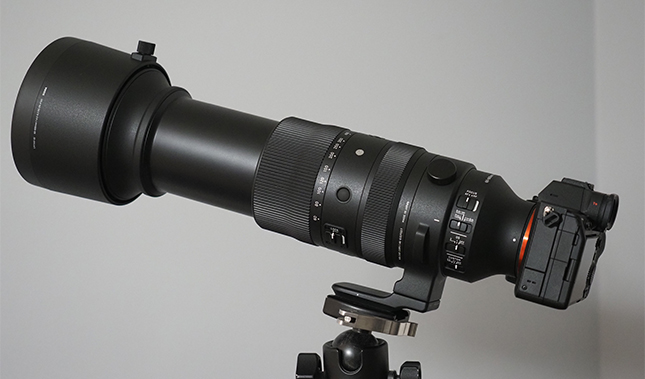Sigma 60-600mm Hands-on Preview: A 10x zooming “Bigma” lens arrives for Sony E-mount and L-mount mirrorless cameras
posted Thursday, January 12, 2023 at 8:30 AM EDT
Click here to browse our Sigma 60-600mm Gallery

Wildlife, nature, and outdoor sports photographers should all take notice, as Sigma has added yet another extremely versatile telephoto zoom to its arsenal of mirrorless lenses. The new Sigma 60-600mm F4.5-6.3 DG DN OS Sports for Sony E-mount and L-mount full-frame mirrorless cameras is unique amongst Sigma's existing telephoto zooms for mirrorless cameras -- and indeed the full-frame mirrorless market as a whole -- being the world's only 10x optical zoom lens for full-frame mirrorless cameras.
The new Sigma 60-600mm fits in alongside their 100-400mm DG DN Contemporary and 150-600mm DG DN Sports lenses as yet another option for a versatile telephoto zoom. Meanwhile, Tamron also has their selection of competitors (at least for E-mount systems), including a 100-400mm, a 150-600mm and a somewhat similar 50-400mm wide-ranging zoom lens. However, nothing so far can match the sheer zoom range versatility of Sigma's new 60-600mm lens, offering an impressive all-in-one lens spanning standard focal lengths, telephoto and supertelephoto.

DSLR owners and eagle-eyed Sigma fans may recognize a similar lens, the 60-600mm F4.5-6.3 DG OS HSM Sports lens, which was released back in 2018. This new mirrorless version of the new "Bigma" lens, however, is more than just a mount change for newer mirrorless camera systems. It's an all-new lens, with a different optical formula, new focusing capabilities, an all-new autofocusing system, improved image stabilization, updated design and much more.
This is essentially a do-it-all lens for any sort of outdoor or telephoto shooting pursuits, and if you're a Sony or L-mount system photographer looking for a single-lens solutions for nature, wildlife, sports, safaris and beyond, the new Sigma 60-60mm DG DN Sports lens is worth considering.
I've had an opportunity to test out a pre-production sample of this new Bigma lens paired up with a Sony A7 IV. Read on for a full rundown of the new lens's specs and features as well as a sampling of real-world gallery images and some thoughts on usability and handling.

Key Features & Specs
- All-in-one 10x telephoto zoom lens for full-frame mirrorless
- Updated optical design with 27 elements in 19 groups (incl. 2 FLD and 3 SLD elements)
- Optical Image Stabilization with 6 stops at 600mm; 7 stops at 60mm
- Newly-designed HLA linear motor-based autofocusing system
- Dual action zooming mechanism (zoom ring + push-pull zoom)
- Weather-sealed construction
- Multi-material construction helps reduce size and weight while remaining highly durable
- Weight: 2,495g (5.5 lbs.)
- Length: 279.2mm (11 in.) at 60mm
- Built-in Arca-Swiss-compatible tripod foot
- Screw-on lens hood
- Sony E-mount, L-mount versions
- $1999 MSPR
Optical Construction
Although this new 60-600mm lens shares the same focal length range, the same variable aperture and a generally similar physical design, the new mirrorless version of Sigma's 60-600mm full-frame lens is indeed different than the earlier 60-600mm F4.5-6.3 DG OS HSM Sports for DSLR cameras and uses a different optical layout. The new 60-600mm F4.5-6.3 DG DN OS Sports uses 27 optical elements, two more than the 2018 DSLR version. Both lenses, however, arrange the elements into 19 groups. This mirrorless version includes two FLD ("F" Low Dispersion) glass elements and three SLD (Special Low Dispersion) glass elements. (The DSLR version used 1 SLD and 3 FLD elements.)

Sigma's FLD glass is an ultra-low dispersion glass that behaves similar to fluorite glass, offering high light transmittance and very low dispersion that helps suppress chromatic aberration and increase sharpness and contrast. Similarly, the SLD elements are another type of low-dispersion glass element and also work to suppress chromatic aberrations, color fringing and help ensure good sharpness.
The 60-600mm DG DN lens features a 9-bladed circular aperture diaphragm for nice, smooth bokeh in out-of-focus areas and features a variable maximum aperture range of F4.5 to 6.3 -- the minimum aperture at 60mm is F22 and F32 at 600mm. The lens's maximum F4.5 aperture only stays that wide for a short while; once you zoom to 80mm, the maximum aperture narrows slightly to F5.0. It hits F5.6 at 150mm, and then F6.3 around 400mm and beyond.

Focusing
Another major update to this new mirrorless version of the 60-600mm lens is its new autofocusing system. This lens uses a newly-developed linear motor AF system, dubbed High-response Linear Actuator (HLA), whereas the DSLR version used an HSM, or hypersonic motor mechanism to rotationally drive the focusing group. With this new lens, the AF group is directly driven with a linear motor, which should offer faster, more precise and quieter autofocusing performance. According to Sigma, the new HLA focusing motor help provide "unparalleled high speed and high precision" focusing performance as well as fast subject-tracking/follow-focusing performance.
Close-focusing is also improved slightly at the shorter end, now focusing down to 45cm (17.8 in) at 60mm. At 600mm, the minimum focusing distance remains at 260cm (102.4in). The lens's maximum magnification is also slightly better as well, with a 1:2.4 magnification ratio at 200mm -- whereas the DSLR version had a 1:3.3 ratio at 200mm. In the field, the close-focusing feels surprisingly good, especially at the shorter focal lengths, and I found myself easily capable of photographing fairly close subjects.

In terms of autofocusing performance, it's too early to make final judgments. As mentioned, the lens I've been testing has pre-production firmware, and Sigma specifically states that the focusing performance, particularly subject-tracking performance, hasn't been finalized yet. That being said, my experience so far has been very positive with general shooting and focusing speeds, so the fact that the lens is likely to get even better at focusing and focus tracking is excellent news. I've not run into any issues with focusing. Speed and accuracy are both up to the performance I expect from a high-end enthusiast zoom lens like this. Using this lens combined with the Sony A7 IV and Bird-detection AF worked wonderfully during my so far fairly short time with the lens at this point.
Design & Handling
Much like its DSLR-format sibling, the new Sigma 60-600mm DG DN is a fairly large and hefty lens, weighing in at 2,495g (5.5 lbs.) and having a retracted length of 279.2mm (11 in.). The lens is slighter than the older DSLR version, which weighed 2700g (5.9lbs), but the length is the same, as is the diameter, with a maximum diameter of 119.4mm or 4.7in. The lens features a 105mm screw-on front filter size, much like the DSLR version.
The length of the 60-600mm lens extends outwards quite a bit as you zoom, with the length increasing to about 38.1cm (15 in.) at 600mm. The screw-on lens hood itself is approximately 8.5cm (3.35in) long, and, when attached, it adds about 6.4cm (2.5 in.) to the length of the lens.

In hand, you definitely notice the weight of this lens. It's built like a tank, much like other Sigma Sports-series lenses I've used. It feels incredibly well built and sturdy. The lens is constructed with a blend of materials, including magnesium, Carbon Fiber Reinforced Plastic and Sigma's Thermally-Stable Composite material, which is a polycarbonate material with thermal expansion characteristics similar to aluminum. The lens is both dust- and splash-resistant, with weather sealing built around the mount, zoom and focus rings, and the various switches and buttons around the exterior. Additionally, the front element has a water and oil-repellant coating to help with cleaning and protection against dirt and moisture.
The lens doesn't seem all that large in person, despite the impressive 10x zoom range, but you will start to notice the weight after carrying it around for a while. Paired with a Sony A7 IV, I just managed to squeeze it into my small Lowepro Flipside Sport 10L camera backpack, albeit with the lens hood reversed and no other camera gear inside. Walking around with the lens in-hand, I definitely became keenly aware of the weight after a while. That said, I still only used the lens handheld, and felt generally comfortable and balanced, even with a non-gripped Sony camera body. Supporting the lens at the large, ridged zoom ring, I was impressed by how nicely balanced the lens felt, at both 60mm and at 600mm, despite the extended length of the lens. In fact, the lens actually feels slightly more comfortable and balanced at 600mm than fully retracted to 60mm, at least with this smaller, non-gripped A7 IV attached.

In terms of external features, the Sigma 60-600mm DG DN lens has two control rings, a smaller one for focusing and a large zoom ring. The focus ring is about an inch or so wide, while the focus ring is about twice as wide. The focusing ring freely rotates whether it's in AF or MF mode, and rotates very smoothly. The zoom ring is also very smooth, though it has much more physical resistance and dampening when you rotate it. As one might expect with a 10x zoom there's quite a bit of rotation require to zoom through the full range, at over 90-degrees of rotation to go through the full range.
The zoom ring features focal length markings at 60mm, 80mm, 100mm, 120mm, 150mm, 200mm, 300mm, 400mm, 500mm and 600mm. The lens also has a locking switch on the lower left side. The lens does have a tendency to exhibit "lens creep" with the lens extending outwards when facing down (or vice versa), so the lock switch comes in handy when you're not shooting and just walking around with the lens. However, you can also lock the lens's zoom position at each of the marked focal lengths, which I think is rather clever and a helpful feature. If you're shooting a longer focal length and pointing the lens upwards, the lens can start to retract slowly on its own, so the lock switch can prevent this. That's a nice, helpful usability feature that I don't always see on long-zooming lenses.

Speaking of zooming, in addition to the zoom ring, the Sigma 60-600mm can also be operated as push-pull zoom lens. There is a ridge right beyond the zoom ring to help grip the lens barrel, allowing for quicker push-pull zoom action. Sigma calls this a "dual action zoom," letting you operate the zoom either with the ring or by pushing and pulling. When photographing fast subjects that are moving erratically or are moving closer or further away from you, push-pull zooming can be much faster than rotating the zoom ring, so it's great to have both methods here at your disposal.
In terms of buttons and switches, the Sigma 60-600mm lens has as series of switches on the left side of the lens, including an AF/MF toggle switch, 3-way focusing distance limiter switch, OIS switch and a Custom Function slider switch. The lens also has two customizable buttons place between the focus and zoom ring.

There is also a built-in tripod foot with soft stops at each 45-degree position. The full tripod foot ring component itself is not removable, but you can unscrew the foot portion altogether if you want. The foot itself features built-in Arca-Swiss dovetailing for easy compatibility with several different tripod/monopod heads.
Image Quality - An initial look
Once again, this is a pre-production sample, so I'm not going to make a final judgment on image quality just yet. However, what I'm seeing so far is very impressive. I spent much of my time photographing small birds and other tiny critters, as that was pretty much all I found while exploring the outdoors with this lens. Most of my time shooting I found myself at the longer focal lengths, especially at 600mm F6.3, and the results look great. The image quality so far looks fantastic, with excellent sharpness, great contrast and minimal CA, both at the center and out toward the edges.


Once again, I loved zooming in on a 33MP A7 IV image and seeing all the intricate feather detail. As mentioned, I mainly came across small songbirds, especially at this time of year, and the 600mm focal length really came in handy to help zero-in on these small birds. So far, I'm really impressed not only by the lens's versatility but also by the sharp images I managed to capture at the full 600mm focal length.


The built-in image stabilization, too, proved very helpful, especially when using the lens handheld. Compared to the 2018 DSLR version of this lens, the OIS system has been significantly upgraded. The older version offered up to four stops of stabilization correction, whereas this new version is rated for up to six stops at the telephoto end and seven stops at the shorter end. Even with just framing and composing shots at 600mm, having that smooth and steady view through the viewfinder was extremely helpful. The IS also helps when shooting in lower light conditions, such as in the forest or cloudy conditions, and allows for slightly slower shutter speeds and lower ISO settings.
If you want to check out a sampling of real-world photos, head over to our Image Gallery for a variety of images to download.
Pricing & Availability
The Sigma 60-600mm F4.5-6.3 DG DN OS Sports will go on sale beginning in mid-February 2023 and will have a retail price of $1,999.